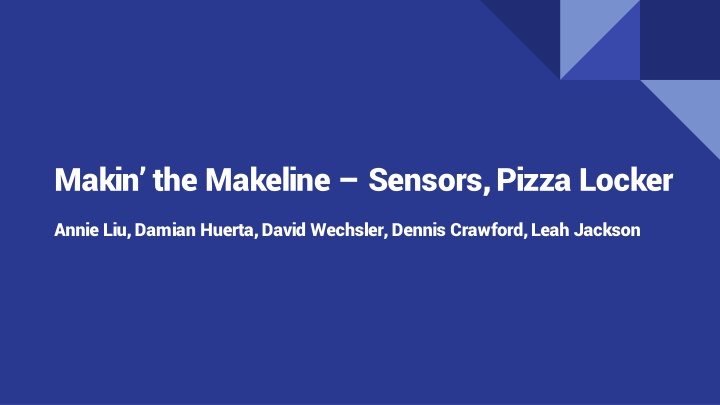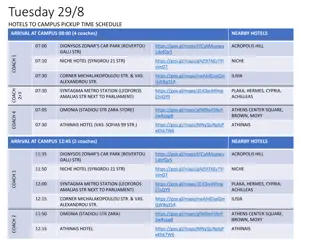Innovative Pizza Pickup System: Makin the Makeline
The project aims to streamline pizza pickup by introducing heated lockers connected to a user-friendly app. Customers order via the app, receive a QR code as a key to their locker, and pick up freshly heated pizza within 5 minutes. The physical locker design ensures pizza temperature maintenance and ventilation. A micro-controller facilitates communication with the app and hardware components, while the UI app displays locker data for both customers and employees.
Download Presentation

Please find below an Image/Link to download the presentation.
The content on the website is provided AS IS for your information and personal use only. It may not be sold, licensed, or shared on other websites without obtaining consent from the author.If you encounter any issues during the download, it is possible that the publisher has removed the file from their server.
You are allowed to download the files provided on this website for personal or commercial use, subject to the condition that they are used lawfully. All files are the property of their respective owners.
The content on the website is provided AS IS for your information and personal use only. It may not be sold, licensed, or shared on other websites without obtaining consent from the author.
E N D
Presentation Transcript
Makin the Makeline Sensors, Pizza Locker Annie Liu, Damian Huerta, David Wechsler, Dennis Crawford, Leah Jackson
Introduction Our main objective for this project is to design a product that allows customers to efficiently pick up pizza whenever they want. Workers in Papa Johns have trouble getting people in and out of the store within 3 minutes. On average, it takes between 7-8 minutes. In order to allow customers to have a faster and better experience with ordering their pizza, we proposed heated lockers that are connected to an application. This application will allow customers to order their pizza, then retrieve a QR code that will act as a key to opening a locker to their fresh pizza. Our performance goal is to have customers in and out of the store within 5 minutes of showing up. This is similar to Amazon Hub Lockers, where buyers are notified when their package has arrived, and they are sent a barcode to pick up their package. Workers in the back load the package within a few minutes of the buyer's arrival so that they are in and out within a few minutes. Our budget for the product is 1,000 dollars. Some of our future work may include building more sustainable lockers.
Design Idea -Physical Locker The physical locker must maintain the pizza temperature between 150 200 Fahrenheit. This temperature is subject to change based on further testing of ideal pizza temperature within a cardboard box. Each locker must have some sort of ventilation to ensure appropriate moisture is maintained so that the food does not dry up or become soggy. Further specification on this will be collected via experiments. Each locker must be able to fit a reasonable order size of 2-5 pizzas or have varying sizes for different sized orders. This size can be obtained by viewing data of the average pizza order as well as the dimension of pizza boxes, breadstick boxes, and dessert containers. There should be no access available to an individual locker unless you are the end consumer or an employee placing the order into the locker. The Physical locker must be able to be powered by a regular 120V 15A outlet.
Design Idea -Micro-controller Our micro controller must be able to interface with some user interface to provide UI and make order pickup as simple as possible. The micro controller must be able to communicate via the web to our user-application back end to send/receive data. The micro controller must be able to interface with hardware such as a temperature sensor, locking mechanism (solenoid), potential infrared lighting system, and QR code reader.
Design Idea -UI The application must be able to read and display data from the actual locker unit to the end user (information from microcontroller), such as temperature, status of order, locker number to retrieve order from. The application must be able to be used from a customer perspective and employee perspective to store/retrieve pizza in lockers.
Test Analysis -Physical Locker Experiments can be designed to place pizza inside our proto-type and simulating user wait times while monitoring the temperature inside for a given order to test the insulation qualities, temperature sensors, and ventilation system. Structural test Test the locker size to make sure pizza fits
Test Analysis -Microcontroller Make sure our software state machine works as intended Another test for our microcontrollers can be to test each individual external hardware component such as temperature sensors, locking mechanism, and screen. The final main test to be performed will be testing the network connection between the Raspberry Pi and our user application back-end.
Test Analysis -Application Interface properly displays data and QR Code should be visible. This should be demonstrated with dummy data Make sure it can send and receive data from microcontroller system. Accounts must be tied to ether customer account or employee account.






















